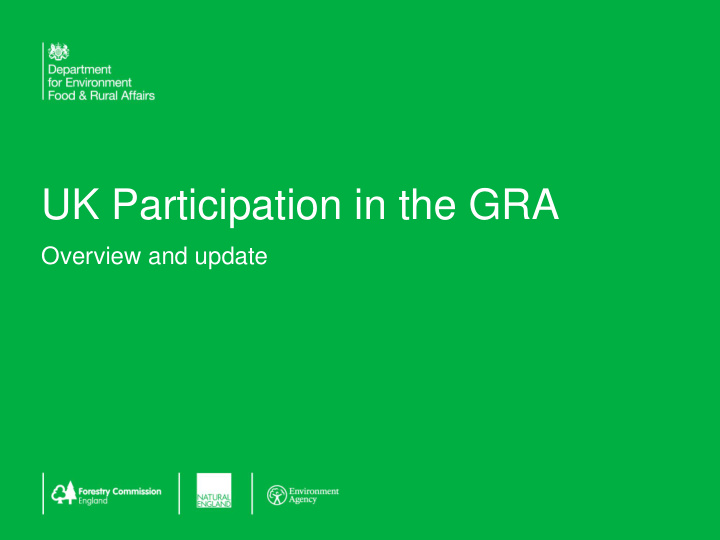



UK Participation in the GRA Overview and update
About the GRA • The GRA brings countries together to develop ways to grow more food without increasing GHG emissions. • Established in 2009, the GRA aims to address the global challenge of mitigating GHG emissions and increasing soil carbon sequestration without impacting agricultural productivity, focussing on reducing GHG emissions intensity (emissions per unit of output). • Founded on the voluntary, collaborative efforts of member countries, aims to enhance scientific capacity via active exchange of data and research, development and extension of technologies and practices and identifying research gaps and potential opportunities for new cross-national research collaborations. • Activities are progressed by three research groups • Livestock • Croplands • Paddy Rice • Plus a cross-cutting Integrative Research Group. Text in footer 2
Member Countries Breaking News! Senegal joined the GRA this September! Text in footer 3
Working in Partnership with Others Text in footer 4
Text in footer 5
The UK’s Involvement to Date • Croplands Group • Co-authoring N 2 O measurement guidance • Establishment and maintenance of the GRAMP modelling platform • Data provision • Participation in MAGGNET • Provision of N 2 O data sets via the AEDA archive • Updating the IPCC emissions factor database • Livestock Group • Co-authoring best practice guidance, and technical manual on low cost chamber measurements • Participation in a range of networks including • Animal Selection & Genetics • Rumen Microbial Genomics Network • Manure Management Network • Feed and Nutrition Network • Leadership of the Animal Health Network • Cross Cutting Group • Scoping the opportunities for EO to provide activity data • Co-authoring best practice guidance for measuring soil carbon Text in footer 6
Going Forward: GRA Strategic Plan Text in footer 7
Recent Developments and Opportunities GRA Flagships – Strategic Plan 2016-2020 • GRA Council adopted its first Strategic Plan, which included as part of its priority actions: “Identify possible GRA Flagship Research Projects for presentation to and review by the Council for potential adoption on an annual basis. “ • Flagships will make a major contribution to the GRA: • Reducing greenhouse gas emissions while supporting food security • Advancing global knowledge through collaboration • Supporting countries in their developing and implementing solutions • Promote synergies between mitigation and adaptation • Flagships are thematic areas that will be advanced through specific actions and can include research, capacity building, guidance and transfer. • Excellent opportunity to align Council members' domestic research programmes and Partner activity to the Flagships and to utilise upcoming research calls, both of the GRA and of GRA Partners Text in footer 8
GRA Flagships What are they and how will they work? • The flagship should offer unique GRA added value by utilising the knowledge and expertise across the GRA member countries and Partners. • The flagship must be inclusive and provide opportunities for all GRA members and partners to be engaged in some way. Lack of new funding to allocate to flagship projects by individual countries should not be or remain a major barrier to those countries engaging in activities to which they could add value, and from which they could gain benefit. • The range of projects should be relevant : all GRA members need to have benefit from some or all of the flagship. It is unlikely that every individual project will provide benefit to everybody, but the collection of projects and activities should provide benefits to all GRA members. Text in footer 9
GRA Flagships What are they and how will they work? • Activities should be solution focused and demonstrate a clear link to the development and implementation of mitigation practices/technologies relevant to diverse needs of GRA member countries. • The range of activities and projects needs to be multifaceted and support and create links across policy needs in countries’ climate and development agendas. • Increasing the capacity/capability of member countries to engage in efforts to estimate, measure and reduce emissions is a critical element of the flagship, and necessary to ensure the flagship is inclusive and relevant. Text in footer 10
Flagship Proposals Council Endorsed Proposals • GRA Council endorsed development of four GRA Flagships: • Enteric Fermentation • Agricultural GHG Inventories • Soil Carbon Sequestration • Water Management in Rice Production • …and Nitrous Oxide to be developed. • Task Forces comprising lead authors, contributing authors and review authors, were established. • Task Forces prepared Flagship project proposals that outline work to be done, the resources available, and the resources needed (including types of resources, e.g. research funding, post-doc, etc.). Text in footer 11
UK Involvement and Commitments How will the UK’s participation be managed? • Continued support for T&S to engage with workshops and activities via our international collaborations fund • Continued engagement with the AHN after the handover of the chair to Germany • Maximising opportunities for collaboration via the ERAgas ERAnet projects (RumentPredict, CEDERS, ResidueGAS) • Participation in the Enteric Fermentation and Agricultural GHG Inventories Flagships • Leadership of the RumenPredict+ proposal under the Enteric Flagship • Links to LRG’s Rumen Microbial Genomics Network • Builds upon the JPI-FACCE ERAgas ERAnet RumenPredict project • Engagement and support for the other 3 Enteric Flagship proposals including data provision from the GHG R&D Platform • Engagement and support for the Inventory Flagship proposals including data provision from the GHG R&D Platform and sharing of experiences in developing our T2/T3 national inventory Text in footer 12
Recommend
More recommend